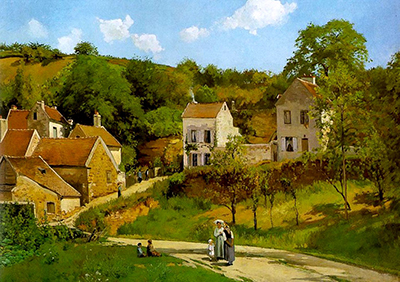Camille Pissarro represented a view of a winding village path at the base Pontoise, France, where he travelled to back and forth between 1866 and 1883, choosing the capital of the province as a series of large-scale landscapes well known as his first masterpieces.
Villagers and beautifully landscaped gardens populated the pastoral area of Pissarro. It extended the French academic tradition, ranging from the fable of Poussin to the original cubist landscape of Paul Cézanne, who studied and worked with Pissarro.
Pissarro often stripped images of their historical and emotional tone, which represented the ideas of his predecessor. Like magic, he used light and darkness to show the effects of the sun and shadows, not just mere interests in the sun. As the art theoretician Charles Bran then wrote, this expression meant “responding to the feeling that the painter wanted to express, rather than relaxing the form and following the customs of moral beauty”.
Gustave Courbet, Edouard Manet, and the Barbizon School established the drawing conventions used by Pizarro at the Hermitage Museum, but this painting is also a product of its era. The same year that Marx announced Das Kapital, Pissarro chose a group of people and many critics thought these people had vulgar choices in painting. Abandoned by Pizarro’s socialist sympathy, his work avoided the limits of traditional academic painting, which focuses on distant scenes from the real world he wanted to explain.
Pissarro later abandoned this realistic style of loose brush and his well-known atmospheric effect, popularly known as the trademarks of Impressionism. We often consider Camille Pissarro the first Impressionist painter, including his outdoor aerial photographs, such as The Road of Pouilly, Pontoise (1881), Paul Cézanne and Paul Gorgan. Known for the mentoring other artists, Pisarro was inspired by the realists of Jean François Millet and Gustave Courbet.
Jacob Camille Pissarro spent his childhood in the West Indies, where his father prospered. He was born on July 10, 1830, St. Thomas. He did his primary studies in a boarding school near Paris. Back in St. Thomas, the young man took a little interest in the family business and spent most of his time painting. At 25, Pissarro gave up his comfortable bourgeoisie and went to live in Paris.
After moving to Paris in 1855, Pissarro also accepted the artistic direction of Jean-Baptiste Camille Corot, who directed him to open-air painting. Pissarro, however, was more concerned with spontaneity than Corot. Pissarro collaborated with artists Paul Signac and George Sula from 1885 to 1888, but Pissarro felt that special attention could not capture natural movements and chance.




